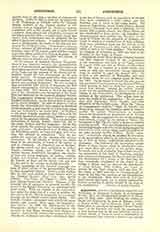

Augustinus, ANTONIUS, historian of canon law and Archbishop of Tarragona in Spain, b. at Saragossa February 26, 1517, of a distinguished family; d. at Tarragona, May 31, 1586. After finishing his studies at Alcala and Salamanca, he went to Bologna (1536), to Padua (1537), and to Florence (1538) in which latter place he examined the famous “Codex Florentinus” of the Pandects and made the acquaintance of such learned men of the new historical school as Andrea Alciati, to whom he owed a confirmation of his pronounced bent towards a positive and critical treatment of the ancient materials of canonical jurisprudence. In 1541 he took his degree of Doctor of Civil and Canon Law and in 1544, at the request of the Emperor Charles V, he was made Auditor of the Rota by Paul III. In 1555 he was sent by Paul IV to England, with a message of congratulation for Queen Mary and as Counsellor to Cardinal Pole. In 1556 he was made Bishop of Alife, in the Kingdom of Naples, and in 1561 was transferred to Lerida in his native Spain. He assisted during three years at the Council of Trent and urged ardently the reformation of the clergy. “It is our fault”, he said in the council, “that so great an agitation has arisen in France and Germany. We must begin with the reformation of the clergy. It is your business, O Fathers, to save by your decrees the common weal of the Church that is now threatened.” In 1576 he was promoted by Gregory XIII to the archiepiscopal See of Tarragona.
Augustinus is one of the foremost figures of the Catholic Counter-Reformation that set in with so much vigour and success in the latter half of the sixteenth century. His chosen field was the Pontes, or original sources of ecclesiastical law both papal and conciliar, The basis of the medieval canon law was the “Decretum” of Gratian, a useful codification of the middle of the twelfth century, the ecclesiastical lawbook of the schools and the universities, of great academic authority, but never formally approved by the popes as church legislation. Its materials, never hitherto critically illustrated as to their prominence and form, and often badly corrupted as to their text, stood in need of judicious sifting and elucidation. It was to this task that the young Augustinus addressed himself from 1538 to 1543. In the latter year he published at Venice the first critical study on Gratian, “Emendationum et Opinionum libri IV”, the result of four years’ labor at the text of the old medieval Benedictine of Bologna. This text remained his lifelong study; towards the close of his career, after important services rendered during ten years to the “Correctores Romani” in their edition of Gratian (Rome, 1582), he finished his own magisterial examination of the work; it was not, however, published until after his death, “De Emendatione Gratiani dialogi (30) libri II” (Tarragona, 1587).
Other important publications of the sources of civil and ecclesiastical law occupied his pen. Thus he published in 1567 an edition of the Byzantine imerial constitutions, in 1576 his “IV Antiquie Col-Fctiones Decretalium”, in 1582 a treatise on the “Penitential Canons” together with a”Poenitentiale Romanum” discovered by him. From 1557 he sought earnestly for the necessary patronage, papal or regal, to enable him to publish the hitherto unedited Greek text of the ancient ecclesiastical councils, and for that purpose examined many archives in Italy and Germany; the fruits of his labors were reaped at a later date by others. Among the more valuable of his posthumous publications, and appealing strongly to modern historical tastes, is a critical examination of several early medieval collections of canon law that served as original material for the “Decretum” of Gratian. This work, that Maassen and von Scherer speak of with respect, is entitled “De quibusdam veteribus Canonum Ecclesiasticorum Collectionibus Judicium et censura”, and was published at Rome (1611) with the second and third parts of his “Juris Pontificii Veteris Epitome” (to Innocent III, 1198-1216), the first part of which appeared at Tarragona in 1587. It contains biographical and text-critical notes on a number of collectors of ecclesiastical laws, from the sixth to the twelfth century. In this work he treats progressively of the pseudo-Isidorian Decretals, and while he did not dispose of sufficient material to demonstrate thoroughly their spurious character or to attempt to fix the time and place of their compilation, it is clear that he did not believe them earlier than the time of Pope Damasus (366-384) or even of the seventh century “Collectio Hispana”. His notes on the correlated “Capitula Hadriani” (Angilramni) were published at Cologne in 1618. His powerful genius was truly universal. Classical philology, epigraphy, numismatics, above all the history of civil and ecclesiastical law found in him an investigator whose boldness and insight were extraordinary for that period of incipient historico-critical research. Death surprised him at the patriotic task of an edition of the works of the Spanish writer, St. Isidore of Seville. The works of Augustinus were printed in eight volumes at Lucca (1775-74); his life by Siscarius is in the second volume 1-121.
THOMAS J. SHEEHAN

